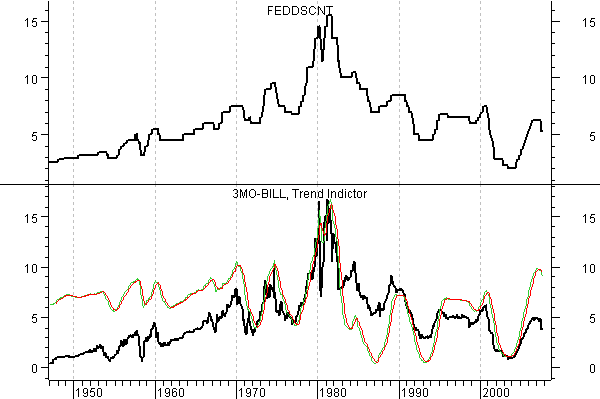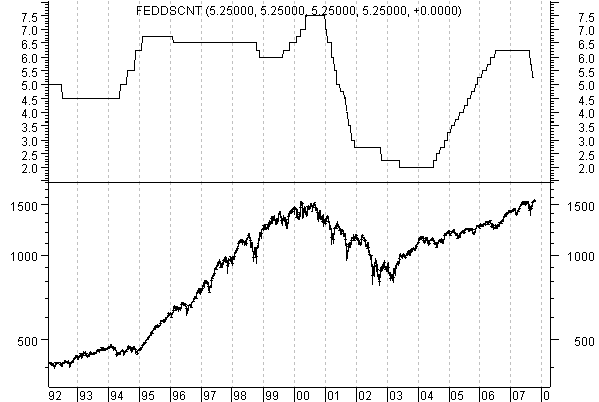The Fed, The Discount Interest Rate and the Stock Market
Stock-Markets / Cycles Analysis Oct 20, 2007 - 01:52 PM GMTBy: Tim_Wood

 The Fed's action to either raise or lower rates has become a major focal point for the markets and in light of the fact that we have another Fed meeting coming up at the end of the month, I felt that addressing this subject again is warranted. Based upon the chart that I first presented here back in September that we have entered into an environment in which further rate cutes should be expected. I have updated this chart below.
The Fed's action to either raise or lower rates has become a major focal point for the markets and in light of the fact that we have another Fed meeting coming up at the end of the month, I felt that addressing this subject again is warranted. Based upon the chart that I first presented here back in September that we have entered into an environment in which further rate cutes should be expected. I have updated this chart below.

In the upper window of this chart I have included the Discount rate and in the lower window we have the 3-month T-bill rate along with my Trend Indictor. As explained here back in September , the Fed does not lead the credit markets in setting the Discount and Fed Funds rate. In going back to 1946, which is the inception of my data base on these rates, we find that the Fed actually follows the natural short-term direction of rates as is defined by the open market. The Trend Indicator in the chart above can be used to help identify when we have moved into a rate cutting cycle or a rate hiking cycle.
The Trend Indicator first rolled over in late June telling us that we had entered into an environment in which lower rates should be expected. It was then in early August that the 3-month T-bill rate began to drop. It was then that the Fed made the first half point cut of the Discount rate from 6.25% to 5.75%. Short-term rates continued to decline and moved well below 3% a bit later in August. This continued decline forced the Fed to follow with yet another half point cut in September. Since that time, short-term rates have rebounded a bit, but are still well below the Discount rate.
Also, as you can see, the Trend Indicator remains negative in the wake of its June downturn. Given that this indicator remains negative today, it is telling us that we are still in an environment in which future rate cutes should be expected. Until the Trend Indicator turns back up, this rate cutting cycle remains intact. I will add that given the spread between the short-term credit market rates and the Discount rate, conditions are suggestive that a cut will follow at the October 31 st meeting as well. I will further add that based upon the script Bernanke seems to be following, the evidence suggests that more aggressive cuts are also in the cards.
Now the question is, will this save the stock market. As long as the Fed gives the market what is expected or even if it cuts more aggressively than is expected, there should be some degree of short-term benefit. But, ultimately these cuts will not support the stock market. This advance is very overdone and believe me, the Fed knows it. Statistically, the stock market has only had one other 4-year cycle advance that has stretched to this degree. Like the pressure that builds up with the movement of the tectonic plates, the pressures of this very extended 4-year cycle advance continue mounting and the earthquake will ultimately follow regardless of what the Fed does.
As an example, I want to talk about another Fed myth and the decline into the last 4-year cycle, which topped in 2000 and bottomed in 2002. I think you will agree that the perception is that the Fed saved the market back in 2001 and 2002 with their aggressive rate cuts. Well, we just established the fact that the Fed follows 3-month T-bill rates. Fact is, the 3-month T-bill rate fell from 6.22% in November 2000 to 5.70% in December 2000. It was then at the January 2001 Federal reserve meeting that the Fed made the first cut of the Discount rate taking it from 7.50% to 7.25%. So, they did not begin cutting as the stock market began to decline out of the January 2000 top. No, the cuts began when the credit markets forced the cuts to begin at the end of 2000 and this can be seen in the chart below, which includes the Discount rate in the upper window and the S&P 500 in the lower window.

As you can see, once the rate cuts began the market still continued lower. In fact, from the time the rate cuts began in January 2001 the S&P 500 fell from 1,283 all the way down to its final low at 768. This was a 40% slide in the S&P in spite of the rate cuts. Fact is, some of these rate cuts did absolutely nothing to hold the market up and in many cases they made multiple cuts and still the market fell. This was particularly true from early 2001 into the fall of 2001. There was a bounce after the 911 bottom, but even the rate cuts following 911 did not prevent the continued decline into the 4-year cycle low in 2002. I don't have the data surrounding the 1920's and 30's, but I do know that the Fed also cut rates and it did nothing to save the market then either.
Technically speaking, the 4-year cycle topped in 2000 in less than 20 months and the statistics told us that as a result a decline to at least the 1998 4-year cycle low was in order. Once that decline began the market simply fell into that low and the rate cuts were of little or no consequence. The same was also true for the 4-year cycle low in 1929 and 1932. Point being, we now sit somewhere near the top of one of the longest 4-year cycles on record, despite what people believe. As a result, the statistics tell us that the market risk remains high.
The longer the market defies these statistics the more pressure is built up on the “tectonic plates” so to speak and once the decline into this over-extended 4-year cycle low begins no one will be able to stop it. In the meantime, I am keeping my subscribers abreast of the specific details surrounding the 4-year cycle, and all subordinate cycles, and we continue to follow the ever so important intermediate-term Cycle Turn Indicator, which turned positive since the week of September 14 th . So, on the one hand we have the statistics telling us that an earthquake is now due, but on the other hand until the intermediate-term Cycle Turn Indicator turns back down, this advance remains intact. It is when the intermediate-term Cycle Turn Indicator turns back down that the opportunity for the decline into the 4-year cycle low will next occur.
In conclusion, the facts clearly show that the Fed follows the short-term credit markets. Furthermore, by following the 3-month T-bill rate lower the impact on equities as they declined into the 2002 low was in reality minimal, if that. But, in spite of these facts it has somehow become a perception that the Fed is a leader at setting short-term rates and that they can save the market by cutting rates. You can see by simply looking at the charts and following what happened that this perception is not factual. I believe that the Fed and the media propaganda machine want us to believe that they are in control or, perhaps it is just human nature to turn to the powers that be when things go wrong, wishing that someone is in control.
Whatever the case, both the Fed and the media have certainly capitalized on this false perception and sold it to the general public. The so-called rate cutting tools are basically smoke and mirrors. The primary tool that actually exists here is the perception that has been fabricated. Moving forward, in order to know when/if this environment changes it will be much more important to monitor the intermediate-term Cycle Turn Indicator on the 3-month T-bill rather than to speculate about what the hidden meaning of the “Fed speak” is. Based on what I see at this time, we continue to be in an environment in which more cuts should be expected. As for these rate cuts saving the stock market, it didn't work in the late 1920's and early 1930's and it didn't work in 2001 and 2002. Will it work this time? Maybe, and perhaps the market even has another push to new highs left in it. But, based on the data, rate cuts are just not likely to have a long lasting impact that will save the market. Technically, this rate cutting cycle is beginning as the equity markets are once again trying to roll over into a 4-year cycle low that is beyond overdue and as a result the stock market risk remains very high.
I have begun doing free Friday market commentary that is available at www.cyclesman.com/Articles.htm so please begin joining me there. Should you be interested in analysis that provides intermediate-term turn points utilizing the Cycle Turn Indicator, which has done a fabulous job, on stock market, the dollar, bonds, gold, silver, oil, gasoline, the XAU and more, those details are available in the newsletter and short-term updates.
The rally that began on August 16th was expected and the key now is confirming its top and when the next opportunity for the decline into the 4-year cycle low is at hand. A subscription includes access to the monthly issues of Cycles News & Views covering the Dow theory, and very detailed statistical based analysis plus updates 3 times a week.
By Tim Wood
Cyclesman.com
© 2007 Cycles News & Views; All Rights Reserved
Tim Wood specialises in Dow Theory and Cycles Analysis - Should you be interested in analysis that provides intermediate-term turn points utilizing the Cycle Turn Indicator as well as coverage on the Dow theory, other price quantification methods and all the statistical data surrounding the 4-year cycle, then please visit www.cyclesman.com for more details. A subscription includes access to the monthly issues of Cycles News & Views covering the stock market, the dollar, bonds and gold. I also cover other areas of interest at important turn points such as gasoline, oil, silver, the XAU and recently I have even covered corn. I also provide updates 3 times a week plus additional weekend updates on the Cycle Turn Indicator on most all areas of concern. I also give specific expectations for turn points of the short, intermediate and longer-term cycles based on historical quantification.
Tim Wood Archive |
© 2005-2022 http://www.MarketOracle.co.uk - The Market Oracle is a FREE Daily Financial Markets Analysis & Forecasting online publication.


